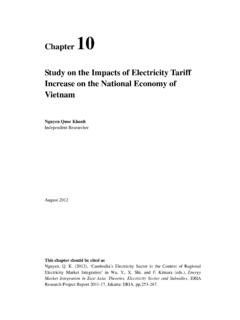Transcription of BEHAVIOURAL ECONOMICS AND …
1 BEHAVIOURAL ECONOMICS AND environmental policy design . Project Description Empirical policy Analysis Unit Environment and Economy Integration Division OECD Environment Directorate July 2012. 1. Background BEHAVIOURAL ECONOMICS is an area of research that tests the orthodox ( neoclassical ) assumptions that individuals are rational, possess all freely available information, and self-interested. This area of research has identified a number of consistent BEHAVIOURAL patterns which systematically violate these assumptions. BEHAVIOURAL ECONOMICS research has played an important role in informing policymakers in areas such as personal health, labour markets, consumer markets and personal finance.
2 A number of OECD. governments have put in place mechanisms which encourage the consideration of insights from BEHAVIOURAL ECONOMICS in their deliberations concerning policy design . In the United Kingdom the BEHAVIOURAL Insights Team sits directly in the Cabinet Office, and has been active across a variety of policy In the European Commission the Directorate-General for Health and Consumers has launched a framework programme to support BEHAVIOURAL ECONOMICS work in the Commission as a In the United States the Office of Management and Budget has drawn inspiration from BEHAVIOURAL ECONOMICS in the areas of health-care provision and financial regulation. The methods utilized in BEHAVIOURAL ECONOMICS research include laboratory and field experiments (or trials), sometimes involving many thousands of people.
3 The advantages of using methods of this kind are that they are easily interpretable by non-experts ( they do not require sophisticated theoretical modelling), and yet provide a scientifically valid way of testing the effectiveness, costs, and public acceptability of innovative policy instruments. In the environmental sphere, BEHAVIOURAL ECONOMICS can inform public policy in two ways: (a). improving benefit-cost analysis (BCA) through methodological adjustments to nonmarket valuation techniques, and (b) informing the development of policy mechanisms to influence environmental behaviour (see Shogren and Taylor 2008 and Brown and Hagen 2010 for recent reviews.). The majority of research on BEHAVIOURAL ECONOMICS in environmental policy currently focuses on non- market valuation.
4 Perhaps the most important insights relate to the interpretation (and thus treatment) of protest responses, as well as the economic valuation of risk and investments in projects with cost or benefits in the distant future. In addition, BEHAVIOURAL ECONOMICS has cast light on issues such as hypothetical bias, as well as reasons for the common finding that WTA does not equal WTP. These have 1. 2. See for details of a conference on consumer policy . 1. important implications for valuation of non-market goods, and thus the optimal setting of policy stringency. However, in this project we focus on the implications for policy design . In order to ensure that policy mechanisms have their intended impact, more applied policy research is required on how responses and attitudes toward specific environmental policies differ from those predicted by standard theory.
5 This is an issue which policy -makers are starting to recognise as potentially being of some 2. Possible Areas of Applied policy Research BEHAVIOURAL anomalies can be explained by factors such as bounded rationality, loss aversion, status- quo bias, cognitive framing, context-dependency, mental accounting and others. However, the full repercussions of different biases remain unclear, and have unknown implications for policy design and implementation. Insights from BEHAVIOURAL ECONOMICS are likely to benefit particularly environmental policy because many of the choices that have significant environmental implications are the outcome of a complex set of motivations. Indeed, such environment-related decisions often require careful consideration between external ( financial), internal ( intrinsic motivations) and social ( norms) factors.
6 This project aims to summarize some of the main policy implications for a sub-set of specific policy areas in which many of these apparent anomalies are important. Possible areas include: energy and water use; resource conservation and agriculture, and waste generation and recycling. With a view toward implementing laboratory or (preferably) field experiments in several countries, specific areas of applied policy research might include the following: 1. Can referencing and peer pressure complement hard environmental policy instruments? For example, can providing information on energy use in the household's community affect consumption choices? There is evidence that some types of low-cost appeals can measurably affect environmental behaviour, such as energy conservation ( letters to households showing their energy use relative to their neighbourhood average).
7 In the first instance it would be interesting to know whether these appeals have different impacts than information on trends on one's own consumption, and how important the impacts are likely to be. Even if the absolute impact of such information provision is not large, it is possible that when implemented in conjunction with a harder policy measure, such as the roll-out of smart meters, they may have a much larger impact than the hard policy on its own. Testing this would necessitate collaboration with electricity providers who are rolling out smart meters in the next few years. Another potential application would be in real-time metering of water consumption or fuel consumption in cars.
8 2. Can governments facilitate bottom-up collective action in the management of natural resources? For example, can facilitating stakeholder groups among farmers facilitate the attainment of ambient water quality standards and other environmental objectives? An informative experiment could analyze the effectiveness of a mandatory tax/subsidy/permit scheme for nutrient pollution in combination with a softer intervention, such as the provision of incentives for the voluntary formation of catchment (watershed) stakeholder organizations where farmers and other polluters interact and work together to collectively achieve an objective. Other potential applications would be in the management of biodiversity, water salinity, and other non-point 3.
9 For example, the European Commission financed a review of the literature in a number of key areas. See 2. source (diffused) environmental problems that require broad support from farmers, forest- managers, or fishermen. There are many case studies of successful watershed organizations and partnerships with government. For example OECD's 2006 environmental Performance Review of Korea, describes a successful self-enforcing catchment organization created by residents near the Daepho River, in response to government pressure. 3. Risk communication and cognitive biases. It has long been known that people have difficulty assessing low-probability but high-impact risks in a consistent manner.
10 This issue could be examined in the context of the development of residential communities in zones at risk of flooding, which has become a problem in many OECD countries. In many cases the perceived risk is not sufficiently important ( once- in-100 year floods) to have an appreciable impact on housing location decisions. Many people are not able to reason about such levels of risk in a coherent manner in terms of trade-offs with other aspects of their housing location choice. Assessing the effect of alternative forms of risk communication on housing location decisions could be undertaken. 4. How does the effect of the mere fact of pricing the environment differ from the level of the price itself?













